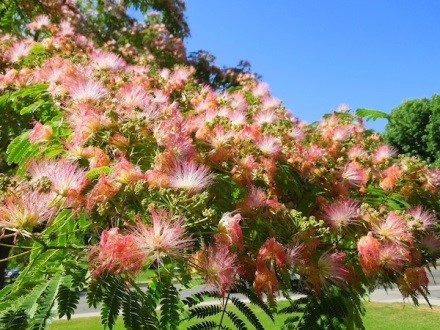The "Red Book" species is preserved and propagated in Dendrology Garden
Albizia julibrissin Durazz. Fabaceae Lindl. Albizia Durazz of the family. is a type of tree belonging to the genus The plant, whose homeland is Asia, is found in temperate climate zones, in addition to subtropical and tropical areas of the world. In Azerbaijan, it is widespread mainly in Talysh territory. The species known as "Lankaran acacia", "Silk acacia" and "Gulabrishin" were included in the "Red Book" of Azerbaijan in 1989. In honor of Fiippledel Albizzi, who saw this tree in Istanbul in 1749 and took it to Florence, the plant is known abroad as Albizia. The scientific name of this species is "gul-i abrisham" in Persian, meaning "silk rose". Silk acacia has been introduced by seeds in Mardakan Arboretum since 1945. Albizia julibrissin Durazz. It is a medium-sized, deciduous tree with a wide canopy, fragrant, bright pink flowers. The young trunks of this tree, which has an aesthetically pleasing appearance, have green color and smooth bark. The bark of the trunk is gray, longitudinally cracked. Silk acacia is a light-loving and heat-loving plant, reaching a height of 9 m and a diameter of 14 cm within 10 years, it blooms and bears fruit only after 4-5 years. The 18-25 cm long leaves are alternately arranged double pinnate. Each leaf consists of twenty to thirty pairs of leaflets, the margins are entire, and they are mutually arranged on a common petiole. Due to the effect of touch, they close slowly at night or on rainy days. The flowers form a small, 5-rayed, head-shaped flower group. Flower clusters are united in large, complex brooms. It is pollinated by insects. Pollen can cause allergic reactions. Male flowers are located on the edges of the head flower group, and bisexual flowers are located in the center. The petals of male flowers are greenish-yellow in color. The corolla of bisexual flowers is long tubular, 8-10 times longer than the calyx, covered with silky hairs. Stamens are numerous, long, thin stalked, protruding far from the corolla, pink in color. They have a great role in attracting insects to the plant. Anthers are small, four-chambered, yellow. They are attached to cluster-like pollen sacs. The tooth is single, with a wire-like column. The plant blooms in June-July and has a long flowering period. Flowers remain on the plant throughout the summer. The fruits ripen in autumn. The bean-shaped seeds are flat, naked linear, 16-20 cm long and 20-25 mm wide. Usually, there are 5-10 seeds in one bean. The seeds retain their ability to germinate for several years. They can spread through wind and water. From the seeds that fall to the bottom of a mature tree, new sprouts are formed in a short time. Seeds are collected in autumn and stored in a cool, dry place until spring. It is a light-loving, heat-loving, low-demanding, wind-resistant, fast-growing plant.
The soil or substrate for Lankaran acacia should be well drained and rich in humus. It is a drought resistant plant. As with all cold-sensitive plants, Lankaran acacia increases its resistance to frost as it ages. To protect it from the cold in the winter for the first few years, the root area should be covered with a layer of leaves, and the stem should be wrapped in wool or mat. Lankaran acacia is relatively resistant to plant diseases and pests. It does not grow well in an open, windy place, because it is susceptible to the effects of strong winds. In the places where the plant is cultivated, it is necessary to plant such planting materials in its neighborhood so that the umbrellas, stems and branches of those plants develop in the vertical direction. Like all trees, this tree needs pruning to thrive and grow. From the end of winter to the beginning of spring, it is necessary to prune damaged, broken and too long branches, and diseased branches should also be removed from the tree regularly. Tools must be disinfected after each pruning operation. Albizia julibrissin Durazz five-year copies of this type are also found in Dendrology Garden. These copies are planted in the open field in full sunlight or in partial shade. The species is used in single and group plantings in the greening of the garden. It is a decorative, honey plant, with a pleasant aroma. Like many legumes, Lankaran acacia has a symbiotic relationship with certain soil bacteria. These bacteria form nodules on roots and fix atmospheric nitrogen. Some of the fixed nitrogen can be used by the growing plant, and some can be used by other plants growing nearby. Lankaran acacia bark and flowers were used as medicine in ancient Chinese medicine. The bark extract was used as a soothing and anti-inflammatory agent for lung diseases and pains, to treat skin ulcers and wounds. Apart from this, it also helps to regulate blood circulation. Asian peoples used Albizia julibrissin bark extract to treat patients with insomnia. The flowers of the plant have been used to treat depression and insomnia. Its seeds are a source of oil and are also used as animal feed. The ore obtained from the shell is widely used in folk medicine. The bark contains 7-8% inoculant, saponin, and dye. Its juice is used in medicine for the treatment of gastrointestinal diseases, and its flower is used for cough. The flowers are collected as soon as they open and dried for later use. It is taken internally when used to treat insomnia, nervousness, shortness of breath and poor memory. One of the main mechanisms behind the plant's antidepressant, anxiolytic and sedative effects is its ability to affect serotonin receptors (specifically 5-HT1A receptors). When used in the treatment of injuries and swellings, it is applied externally. The gum extract from the plant is used as an ointment for boils, wounds and the like, and as a preservative in fractures and sprains. The yellow color obtained from the bark is useful for dyeing silk and woolen fabrics. The plant is also cultivated to prevent erosion in sandy soils. Since Absheron is a decorative species fully resistant to soil and climate conditions, it is considered to be purposeful to use it as an ornamental plant in the greening of parks and gardens.






